As a minimalist enthusiast, I’ve discovered that minimalist furniture can transform your home into a serene, clutter-free oasis. If you’re like me, you probably crave a living space that feels spacious, organized, and inviting. So, let’s dive into this guide, where I’ll share my top tips to help you embrace the minimalist lifestyle while creating a beautiful and functional home.
1. Understand Your Style

Before diving into minimalist furniture, take a moment to reflect on your personal style. Ask yourself:
- What colors and materials resonate with me?
- Do I prefer sleek, modern designs or a touch of rustic charm?
- How do I want my space to feel?
By identifying your aesthetic preferences, you can choose furniture that complements your vision and enhances the overall atmosphere of your home.
For instance, I once experimented with various styles to find the right balance. Initially drawn to stark modern designs, I realized I also loved natural materials’ warmth. This led me to mix minimalist furniture pieces with wooden accents, creating a cozy yet uncluttered environment.
Tip: Create a mood board or gather inspiration from platforms like Pinterest. This visual representation will help you clarify your style preferences and guide your furniture choices.
2. Prioritize Functionality
One of the core principles of minimalism is that every piece of furniture should serve a purpose. As I curated my space, I focused on functional pieces that met my needs without unnecessary extras. Here are a few functional furniture ideas:
- Multi-purpose furniture: Look for items that serve dual purposes, such as a coffee table that doubles as storage or a sofa bed for guests. This not only saves space but also adds versatility to your home.
- Quality over quantity: Invest in fewer, high-quality pieces that will last rather than filling your space with items that don’t serve you well. A well-crafted chair or table can elevate the entire room’s aesthetic.
Functionality in Action
I was determined to make the most of a small living area when I moved into my current apartment. I found a sleek, modern ottoman that could serve as both a footrest and a hidden storage solution for blankets. This piece not only provided comfort but also kept my living space organized.
Tip: Consider your daily routines when selecting furniture. For example, a dining table that can be expanded for gatherings is a great investment if you enjoy entertaining.
3. Choose a Neutral Palette
When it comes to minimalist furniture, a neutral color palette works wonders. Soft whites, grays, and earthy tones create a calming atmosphere that allows the space to breathe. As I experimented with different colors, neutrals made my room feel more cohesive and spacious.
- Accent colors: Consider incorporating small pops of color through accessories like cushions or artwork. This way, you maintain a minimalist aesthetic while adding a personal touch.
I recall one summer when I decided to repaint my living room. I initially thought about a bold color to add excitement. However, I ultimately opted for a soft gray with white trim. The result was a soothing backdrop that allowed my colorful art pieces to stand out without overwhelming the space.
Tip: When selecting colors, think about how they make you feel. Light, airy colors can create a sense of calm, while darker shades may add drama. Choose what resonates with your personality.
4. Embrace Open Spaces
One of my favorite aspects of minimalism is the emphasis on open spaces. You can create a more inviting and airy environment by choosing furniture that doesn’t overcrowd the room. Here are some tips to achieve that:
- Limit large furniture: Opt for smaller pieces appropriately scaled for your space. For example, a compact sofa or a slim console table can provide functionality without dominating the room if you have a small apartment.
- Leave room for movement: Ensure ample space to walk around and interact with your furniture. Arranging my furniture to create clear pathways makes my home feel more welcoming and accessible.
Creating Open Spaces
When arranging my living room, I initially placed my sofa against the wall, which made the space feel cramped. After experimenting with different layouts, I floated the sofa in the middle of the room, creating defined zones for lounging and walking. This simple change opened up the space and made it feel much more inviting.
Tip: Use area rugs to define spaces in larger rooms, giving the illusion of separate zones while maintaining an open feel.
5. Curate Meaningful Decor
In a minimalist home, decor should be meaningful and intentional. I’ve found that displaying a few cherished items rather than overwhelming the space with decorations creates a more personal and cozy atmosphere. Here’s how to curate your decor:
- Select items with stories: Choose decor pieces with sentimental value or spark joy. For example, I display a vase from my travels, which serves as a beautiful centerpiece and reminds me of those cherished memories.
- Limit decor: Aim for three to five decorative items per surface to maintain a clean look. I remember when I had too many knick-knacks cluttering my shelves, and it felt chaotic. Simplifying my decor allowed my favorite pieces to shine.
Tips for Meaningful Decor
When selecting decor, think about how each piece contributes to the overall vibe of your home. I love incorporating plants; they bring life and freshness without cluttering the space. Succulents or small potted plants are excellent options for a minimalist aesthetic.
Tip: Consider using floating shelves to display your curated decor. This creates a visually appealing arrangement while keeping surfaces clear.
6. Keep It Organized
A clutter-free home is the heart of minimalist living. To maintain an organized space, I recommend implementing a few simple practices:
- Regularly declutter: Schedule regular decluttering sessions to evaluate what you truly need and use. I set aside an hour each month to go through my belongings, which helps prevent clutter from piling up.
- Invest in storage solutions: Look for stylish baskets or boxes that can store items out of sight while maintaining a clean look. I found beautiful woven baskets that hold extra blankets and enhance my decor.
Developing an organizational routine
When I first embraced minimalism, I struggled with keeping my belongings organized. However, I created a system where I assign a specific place for everything. This small habit made a huge difference in how I managed my space.
Tip: Use labels for bins or boxes to keep everything organized and easy to find. This will save you time and energy in the long run.
7. Personalise Your Space

While minimalism emphasizes simplicity, injecting your personality into your home is essential. After all, your space should reflect who you are. Consider these tips to add a personal touch:
- Incorporate personal artwork: Display pieces that resonate with you, whether they’re family photos or favorite prints. I’ve created a gallery wall in my hallway, showcasing memories and art that inspire me.
- Add plants: Houseplants enhance the aesthetic, purify the air, and bring life to your home. I’ve filled my space with various plants, each contributing to a vibrant, calming atmosphere.
Adding Personal Touches
Personalizing your home doesn’t have to mean cluttering it. I’ve learned to choose a few standout pieces that represent my personality. These could be bold pieces of art or unique sculptures that capture attention without overwhelming the space.
Tip: Consider rotating your decor seasonally. This keeps your space fresh and allows you to showcase different aspects of your personality.
Engage With Me!
Now that I’ve shared my top tips for embracing minimalist furniture, I’d love to hear from you! What strategies have you found effective in creating your minimalist space? Share your thoughts in the comments below, and feel free to share this guide with friends who might find it helpful!
Conclusion
By embracing the principles of minimalist furniture, you can create a tranquil and functional living space that feels uniquely yours. Remember to prioritize functionality, choose a neutral palette, and curate decor that resonates with you. You can transform your home into a beautiful minimalist retreat with a little thoughtfulness and intention. Happy decorating!
Whether you’re just starting your minimalist journey or looking to refine your approach, these tips will help you navigate the world of minimalist furniture and create a space you love coming home to. Let’s embrace the simplicity and beauty of minimalism together!


